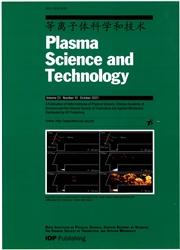Multi-layer phenomena in petawatt laser-driven acceleration of heavy ions
IF 1.6
3区 物理与天体物理
Q3 PHYSICS, FLUIDS & PLASMAS
引用次数: 0
Abstract
Abstract Laser-accelerated high-flux-intensity heavy-ion beams are of importance for new-type accelerators. A particle-in-cell program (Smilei) is employed to simulate the entire process of SEL-100 PW laser-accelerated heavy particles using different nanoscale short targets with thickness of 100 nm Cr, Fe, Ag, Ta, Au, Pb, Th, and U, as well as thickness of 200 nm Al and Ca. An obvious stratification is observed in the simulation. The layering phenomenon is a hybrid acceleration mechanism reflecting Target Normal Sheath Acceleration and Radiation Pressure Acceleration, and this phenomenon is understood from the simulated energy spectrum, ionization, and spatial electric field distribution. According to the stratification, it is suggested that high quality of heavy-ion beams could be expected for fusion reactions to synthesize superheavy nuclei. Two plasma clusters in the stratification are observed simultaneously, which suggest new techniques for plasma experiments, as well as thinner metal targets in precision machining process.千瓦激光驱动重离子加速中的多层现象
激光加速高通量强重离子束是新型加速器的重要组成部分。采用粒子胞内程序(Smilei)对SEL-100 PW激光加速重粒子的整个过程进行了模拟,采用厚度为100 nm的Cr、Fe、Ag、Ta、Au、Pb、Th、U等不同纳米尺度短靶,以及厚度为200 nm的Al、Ca等靶。模拟中观察到明显的分层现象。分层现象是一种反映靶法向鞘层加速度和辐射压力加速度的混合加速机制,可以从模拟能谱、电离和空间电场分布来理解这一现象。根据层析,提出了高质量的重离子束可以用于合成超重核的聚变反应。在分层中同时观察到两个等离子体簇,为等离子体实验提供了新技术,也为精密加工过程中更薄的金属靶提供了新技术。
本文章由计算机程序翻译,如有差异,请以英文原文为准。
求助全文
约1分钟内获得全文
求助全文
来源期刊

Plasma Science & Technology
物理-物理:流体与等离子体
CiteScore
3.10
自引率
11.80%
发文量
3773
审稿时长
3.8 months
期刊介绍:
PST assists in advancing plasma science and technology by reporting important, novel, helpful and thought-provoking progress in this strongly multidisciplinary and interdisciplinary field, in a timely manner.
A Publication of the Institute of Plasma Physics, Chinese Academy of Sciences and the Chinese Society of Theoretical and Applied Mechanics.
 求助内容:
求助内容: 应助结果提醒方式:
应助结果提醒方式:


